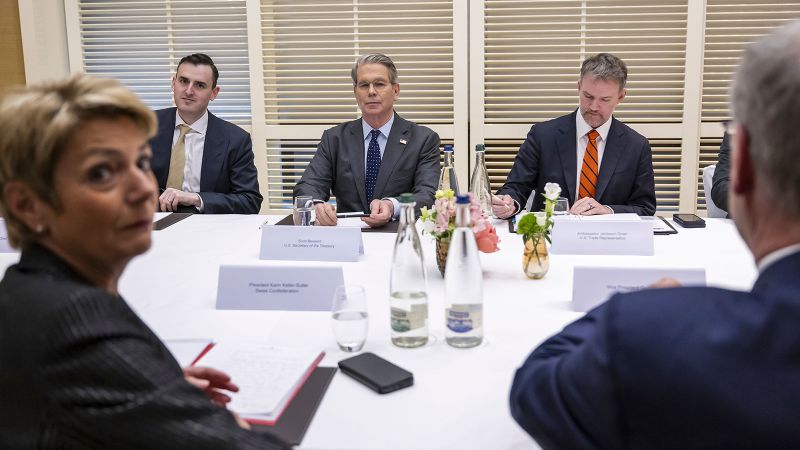In the realm of international trade negotiations, few events capture global attention as significantly as those involving the bustling dialogue between the United States and China. Recently, a pivotal scenario unfolded as President Donald Trump’s trade negotiating team embarked on a critical journey to meet with top Chinese officials in Geneva, Switzerland. Just hours before their departure, Trump utilized social media to introduces a surprising twist, casting uncertainty over the discussions by hinting at the possibility of substantially reducing tariffs imposed on Chinese goods.
Trump’s tweet suggested a drastic reduction of his existing 145% tariffs on China to a mere 80%, leading many observers to question the efficacy and consistency of his negotiating strategy. For some, it appeared as if the president was initiating negotiations with himself, showcasing a lack of clarity about his position even before the debates commenced. However, the essence of this message did not catch Trump’s seasoned negotiators off guard. They had already entertained the notion of lowering tariffs in prior internal discussions in preparation for the anticipated talks. In stark contrast, such information was news to officials in Beijing, showcasing a divide in communication and expectations.
Trump’s mention of Treasury Secretary Scott Bessent in his post was, in part, a strategic move aimed at elevating Bessent’s stature amongst Chinese leaders. Despite this public display of deference, it was well understood among U.S. officials that the final say would ultimately rest with Trump and Chinese President Xi Jinping. Meanwhile, the geopolitical momentum was building as Bessent, alongside U.S. Trade Representative Jamieson Greer, landed in Geneva, ready for two days of discussions which could potentially yield significant, albeit modest outcomes.
The White House had meticulously segmented the trade discussions with China from the frantic diplomatic efforts underway with other nations, especially following Trump’s April 2nd announcement to defer reciprocal tariff rates for 90 days. This separation highlights a strategic approach where ongoing bilateral negotiations with countries in the Indo-Pacific region, including South Korea and Japan, serve as leverage against China.
As the negotiations commenced, Trump’s administration sought a pathway marked by initial steps aimed at de-escalation, followed by concrete actions from China addressing core issues pertinent to the U.S., including the production of fentanyl and the revitalization of the Phase One trade agreement established earlier. These preliminary discussions were seen as foundational in building a comprehensive dialogue about the expansive economic relationship between the two powerhouses.
Greer’s remarks resonated with a cautious optimism, signaling that meaningful discussions could emerge from this series of meetings, although immediate outcomes were more focused on establishing stability rather than sweeping agreements. The discussions also aligned with pressing U.S. concerns about export controls imposed by China on rare earth materials, which may shape early-stage agreements as both nations navigated their complex dynamic.
However, anticipation surrounding the negotiations was always tempered by the understanding that Trump himself was the unpredictable variable in the equation. Together, current and former officials articulated the belief that Trump possessed the discretion to redirect negotiation flows at any moment.
As these discussions commenced, the diplomatic tone had markedly shifted from earlier months marked by tension and isolation. Recent exchanges outlined a clearer commitment from both sides to engage in serious discussions, represented by the caliber of officials present at the talks. Xi Jinping’s trusted advisor He Lifeng led the Chinese delegation, with security official Wang Xiaohong attending in support, highlighting China’s seriousness in addressing trade disparities.
Greer expressed confidence in the productive capacity of the forthcoming discussions, asserting that genuine dialogue could emerge as both sides appeared willing to make headway on real issues. Bessent and Greer represented the forefront of a robust U.S. economic team, reinforcing the strategic depth required to navigate these critical negotiations.
The backdrop of this meeting stemmed from past tensions that had strained relations and prompted economic repercussions for both nations. U.S. officials reflected on the fragile state of China’s economy, underpinning a belief that prolonged trade tensions could yield unfavorable outcomes for Beijing. The series of preparatory engagements from Chinese officials hinted at potential receptiveness to addressing core U.S. concerns, including the issue of fentanyl production.
Ultimately, the negotiations capture the intricate balance of meeting Trump’s overarching goals while navigating the nuances of international diplomacy. The desire to forge a substantial economic agreement with Xi remains a highlight for Trump, likened to a pursuit of an elusive prize, underscoring the complexity of the U.S.-China relationship and the unforeseeable paths it may take moving forward.



